
Most water heaters have a life expectancy of only 7-10 years. Many people don’t think about replacing the water heater in their homes until it starts giving them problems. Instead of waiting until its too late, learn how to keep your water heater in good condition by doing regular preventative maintenance. Continue reading to discover how to flush a water heater and if you have any questions or would rather a Professional plumbing company do it for you, Auger Pros Plumbing would be happy to help!
Running out of Hot water faster than Usual? One of the most obvious signs that you need to drain your water heater is that you are running out of hot water faster than normal. When the sediment builds up too much, the heating element in the tank is at risk of burning.
Strange Popping sounds Coming from the Water Heater? It could be another sign that your tank is in dire need or a flush or on its way out. This happens when minerals build up over time and harden, and when the hot water is in there, it affects the tank.
Rusty looking water? This happens when the anode rod deteriorates. Unfortunately, water heater tanks are made of a material that eventually gets worn down over time.
Leaks in the tank? Huge red flag that your water heater is in trouble. If you notice that your water heater is leaking, the tank may be damaged from sediment buildup over time.
Water heaters account for 18% of energy use in a home. Ignoring these signs, that your water heater tank needs maintenance or is on its way out, could be wasting you a lot of money.

How to Flush Your Water Heater
At the top of the water heater, you’ll see a water pipe and a shutoff valve going into the water heater. Turn this valve to shut off the water to the tank.
It’s important to shut off the power to your water heater before draining it, or you could potentially burn out the heating elements. If you have an electric water heater, shut the power off from your home’s electrical panel. The correct fuse or circuit breaker should be labeled as being connected to the water heater.
If it’s a gas water heater, On some models- you can turn the water heater’s thermostat to “pilot” for this step. Check your owner’s manual and follow the instructions provided for your specific water heater.
The water in your water heater is extremely hot. To help prevent injury, it’s a good idea to let your water heater sit overnight so the water within the tank cools down before you drain it. It is recommended you should wait a few hours at the very least. Taking a hot shower can also help speed up the cooling process
Once your water heater has cooled down, place one end of a hose (you can use a garden hose) into a floor drain or, if it will reach, directly outside. Attach the other end onto the drain valve at the bottom of the water heater.
Open the hot water tap, like a sink faucet, that is nearest to the water heater. This helps to alleviate pressure and allows the tank to drain quicker.
Once you open this valve, the water will begin to flow out of the tank. Be patient, as it make take awhile to drain if the tank was full or there is a lot of sediment.
With the drain valve still open, turn the cold water back on to help eliminate any remaining sediment on the bottom of the tank. Repeat this step until the water runs clear. Then, turn the water valve off again.
Remove the hose from the drain valve, and be sure to close the valve. Turn the water supply back on to start refilling the tank. Once the tank is full, turn the power or gas supply to the water heater back on. Remember to turn off the faucet you turned on earlier while draining the tank.
It’s generally a good idea to drain your water heater at least once a year at a minimum. However, If you live in an area with hard water, aka the North Dallas area, you may need to drain it more frequently, even once a month. Remember, always check your owner’s manual to see what the manufacturer recommends.
Water heaters are typically a fairly low maintenance appliance, but remember to drain yours regularly to keep it running efficiently and the hot water flowing.

Auger Pros Plumbing strongly recommends having our licensed plumbers install a Flow- Tech Max Water Treatment System. It is a maintenance-free, eco-friendly, and cost-efficient water treatment device that controls limescale build-up and removes pre-existing limescale. It is the most advanced chemical-free water treatment system available today.
The most unique feature about it is that it works as a water softener and descaler, whether the water is flowing or not. Flow-Tech Home neutralizes the magnesium and calcium ions in your hard water, allowing them to stay in your water and go out with flow – instead of sticking to your pipes and appliances, such as your water heater. Thus extending their useful life.

If you have any questions about Flushing your water heater, or how Flow-Tech Max Water Treatment System can help you- Please give the professionals at Auger Pros Plumbing & Drain a call at 214-206-6580. One of our helpful technicians can come out and do a water heater flush for you and/or discuss how the Flo- Tech water treatment system could benefit you and help you save on your energy bills.